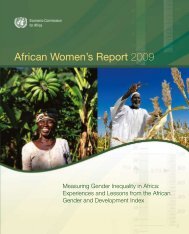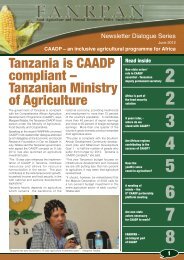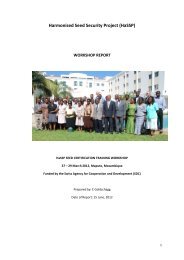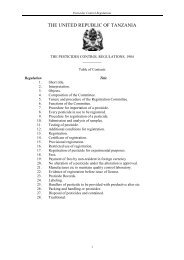Community-driven development decision tools for rural - IFAD
Community-driven development decision tools for rural - IFAD
Community-driven development decision tools for rural - IFAD
- No tags were found...
Create successful ePaper yourself
Turn your PDF publications into a flip-book with our unique Google optimized e-Paper software.
Governments that are keen to make CDD work ought to ensure that all levels of publicgovernance collaborate in CDD project <strong>for</strong>mulation and appraisal. Governments and<strong>development</strong> agencies should make available the time and resources required <strong>for</strong> institutionalassessment and communication <strong>development</strong>. The time and money spent are investmentsthat are likely to pay handsomely in terms of efficiency, speed and the impact of futureproject implementation. 30Preparing the Project Implementation Manual (PIM) can provide a real opportunity toimprove consensus, provided it is done in a participatory manner, involving all stakeholders, thecentral and local government officers and representatives of the local partners’ organizations. Thiswould mean changing the current practice of having consultants produce the PIM in isolationfrom most stakeholders.Some <strong>IFAD</strong> CDD projects have tested preparing the PIM through a participatory process. Ittakes up to six or seven months and costs considerably more than a single consultant’scontract, but it has proven effective in ensuring that most stakeholders, including the newlyappointed project coordinator, understand what needs to be done, how it should be done andwhy. It also helped identify adjustments to local government procedures that later greatlyfacilitated implementation.Relationship with the district administrationCDD projects concerned with developing social and production infrastructure involve centralgovernment ministries that often operate through de-concentrated units at different levels ofgovernment (e.g. region, province, district) or delegated public institutes (e.g. agriculturalresearch institutes) or public enterprises (e.g. water or power companies). Countries that havedevolved responsibility <strong>for</strong> <strong>rural</strong> <strong>development</strong> to the district level must regulate the relationshipbetween the de-concentrated units of the central government, the district assembly and thedistrict executive administration. Those relationships and their mandates are seldom clearlyregulated and, as a result, conflicts of competence and duplication of functions occur,particularly at the district level.De-concentrated units of central government ministries responsible <strong>for</strong> district matters aregenerally expected to act as advisors to the District Assembly and/or as service providers uponrequest from the district administration. In practice, de-concentrated units exercise great influenceon the <strong>decision</strong>s made by local governments. They are expected to monitor whether the districtadministration respects central government standards <strong>for</strong> providing services. They implementtheir ministry’s activities at the district level, which are planned and controlled at the centrallevel. It is not uncommon <strong>for</strong> de-concentrated units to carry out activities mandated from thecentre be<strong>for</strong>e those requested by the districts, particularly when district governments have littletechnical capacity and even fewer resources to conduct their own priority activities.District governments that have responsibility <strong>for</strong> <strong>rural</strong> <strong>development</strong> tend to take authority <strong>for</strong>implementing all projects that affect <strong>rural</strong> communities in their territory. This may include theexclusive authority to plan social and economic infrastructure at the community level, approveall subprojects supported with public funds in these fields and provide services such as primaryeducation, agricultural extension and basic healthcare through the district’s own organization. Insuch cases, there is a serious risk of excessive centralization at the district level, with negativeconsequences <strong>for</strong> the emergence and growth of autonomous CBOs.CDD project designers can reduce the chances of operational problems during projectimplementation by clarifying, as soon as possible, the implementation roles <strong>for</strong> the centralministries’ de-concentrated units, the district administration, the subdistrict administration and30 This methodology was tested with success by <strong>IFAD</strong> projects in India and the Philippines.58
















